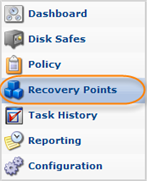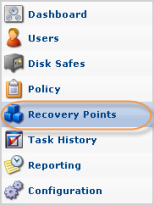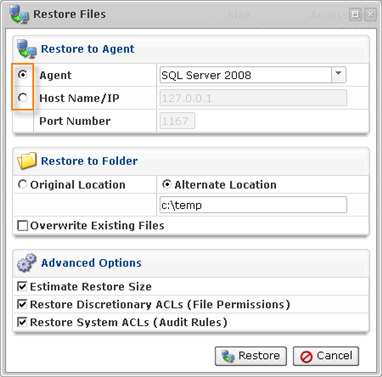R1Soft CDP provides the ability to take a snapshot of the Microsoft SQL server databases. Since CDP is using the VSS SQL writers, it ensures data integrity and consistency during the backup operation.
Follow the instructions below to restore a MS SQL database previously backed up by R1Soft CDP.
Step 1: Restoring Database Data and Log Files
To restore a database, follow the instructions below in your CDP.
1. Click on "Recovery Points" in the Main Menu to open the "Recovery Points" screen.
| Standard Edition | Enterprise Edition | Advanced Edition |
|---|---|---|
 |
 |
 |
2. Select a Recovery Point you want to restore from. You can restore the files from any available Recovery Point. Click on the "Browse" icon in the "Actions" column for this Recovery Point.

| Tip To find a Recovery Point, you can use the Basic and Advanced List Filters. See Customizing the Recovery Points List. |
3. The "Browse Recovery Point" window opens. Browse to locate the location of the SQL data and log files (.mdf and .ldf). See also: Browsing Recovery Points.

4. Check off the database .mdf data files and .ldf log files you want to restore.

5. When you are finished selecting the files and directories, click the "Restore Selected" button.

6. In the "Restore Files" window, define the restore options.
First, select an existing Agent to restore to or define a new Host name/IP and its port number.

Second, if the database already exists and you want to restore the .mdf and .ldf files to an alternate location, check the option and specify the path where the files will be restored. Optionally, check the "Overwrite Existing Files" option.

Third, define the Advanced options if needed:
- Estimate Restore Size
- Restore Discretionary ACLs (File Permissions)
- Restore System ACLs (Audit Rules)

7. Click on "Restore."

8. A notification window will inform you that the Restore task has been scheduled. This means the Task has started. The "Reporting" screen displays the progress of the Task. Click "OK" in the displayed window.

Step 2: Attaching the Database Data and Log Files
Follow the instructions below to attach the database data and log file.
1. From the SQL Server Management Studio, right-click the "Databases" item and select the "Attach..." command in the menu.

2. Browse to the restore location.
| Note If you restored it to an alternate location, the path will include the new location as well as the old hierarchy of the file location. |

3. In the "Attach As" column, change the database name if the original database is still online.

4. Click "OK." The database is now attached.

